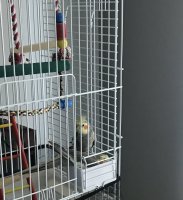hope86
Sitting on the front steps
- Joined
- 6/18/17
- Messages
- 16
Hi everyone,
I got my two cockatiels from a pet store 2 and a half weeks ago. They're both around a year old and are untamed.
From what I've been reading, I really don't have it too bad. I can change their food and water bowls (they slide out of cage) without them even moving. They're scared of new food and new toys and get slightly spooked when I slide out the tray to clean it. I can't put my hand in their cage to clean it because they go crazy.
Their wings aren't clipped and I can't stand the thought of traumatizing them by taking them to a vet. Not yet anyway.
Worried about them becoming cage bound and depressed, I started leaving their cage door open a few days ago. Charlie, the boy, poked his head out for a second and that was it. Coco, my brave girl, sat right under the door all day. Same thing happened the next day. On the third day, Coco flew out almost immediately and Charlie quickly followed. They panicked a little, screamed a few times and then landed on the floor. They spent the rest of the day, from noon until 7:30pm, between the curtains and the window, just staring out and chirping. I thought they'd go back to their cage on their own when they got hungry but they were so happy to be out I think they forgot it existed.
Eventually, I had to grab them to put them back in. They screamed bloody murder and Coco bit me super hard. I don't know who was more traumatized by the experience, my birdies or myself. I felt so guilty for scaring them.
They glared at me for the rest of the night and all of next day. They're back to themselves now but I don't know what to do. On the bright side, I got to scrub their cage clean.
Should I wait until they trust me a little more and at the very least take treats from my hands? (They're a long ways from that.) Or should I take their food bowl out a couple of hours before letting them out again and hope they'll be hungry enough to go back in?
Coco has been trying to lift the door up and even tries squeezing herself through the bars.
I got my two cockatiels from a pet store 2 and a half weeks ago. They're both around a year old and are untamed.
From what I've been reading, I really don't have it too bad. I can change their food and water bowls (they slide out of cage) without them even moving. They're scared of new food and new toys and get slightly spooked when I slide out the tray to clean it. I can't put my hand in their cage to clean it because they go crazy.
Their wings aren't clipped and I can't stand the thought of traumatizing them by taking them to a vet. Not yet anyway.
Worried about them becoming cage bound and depressed, I started leaving their cage door open a few days ago. Charlie, the boy, poked his head out for a second and that was it. Coco, my brave girl, sat right under the door all day. Same thing happened the next day. On the third day, Coco flew out almost immediately and Charlie quickly followed. They panicked a little, screamed a few times and then landed on the floor. They spent the rest of the day, from noon until 7:30pm, between the curtains and the window, just staring out and chirping. I thought they'd go back to their cage on their own when they got hungry but they were so happy to be out I think they forgot it existed.
Eventually, I had to grab them to put them back in. They screamed bloody murder and Coco bit me super hard. I don't know who was more traumatized by the experience, my birdies or myself. I felt so guilty for scaring them.
They glared at me for the rest of the night and all of next day. They're back to themselves now but I don't know what to do. On the bright side, I got to scrub their cage clean.
Should I wait until they trust me a little more and at the very least take treats from my hands? (They're a long ways from that.) Or should I take their food bowl out a couple of hours before letting them out again and hope they'll be hungry enough to go back in?
Coco has been trying to lift the door up and even tries squeezing herself through the bars.


 ) to get back in but they made it. I really didn't want to grab them again so I gave them some more time. They slept on the curtain rod.
) to get back in but they made it. I really didn't want to grab them again so I gave them some more time. They slept on the curtain rod.
